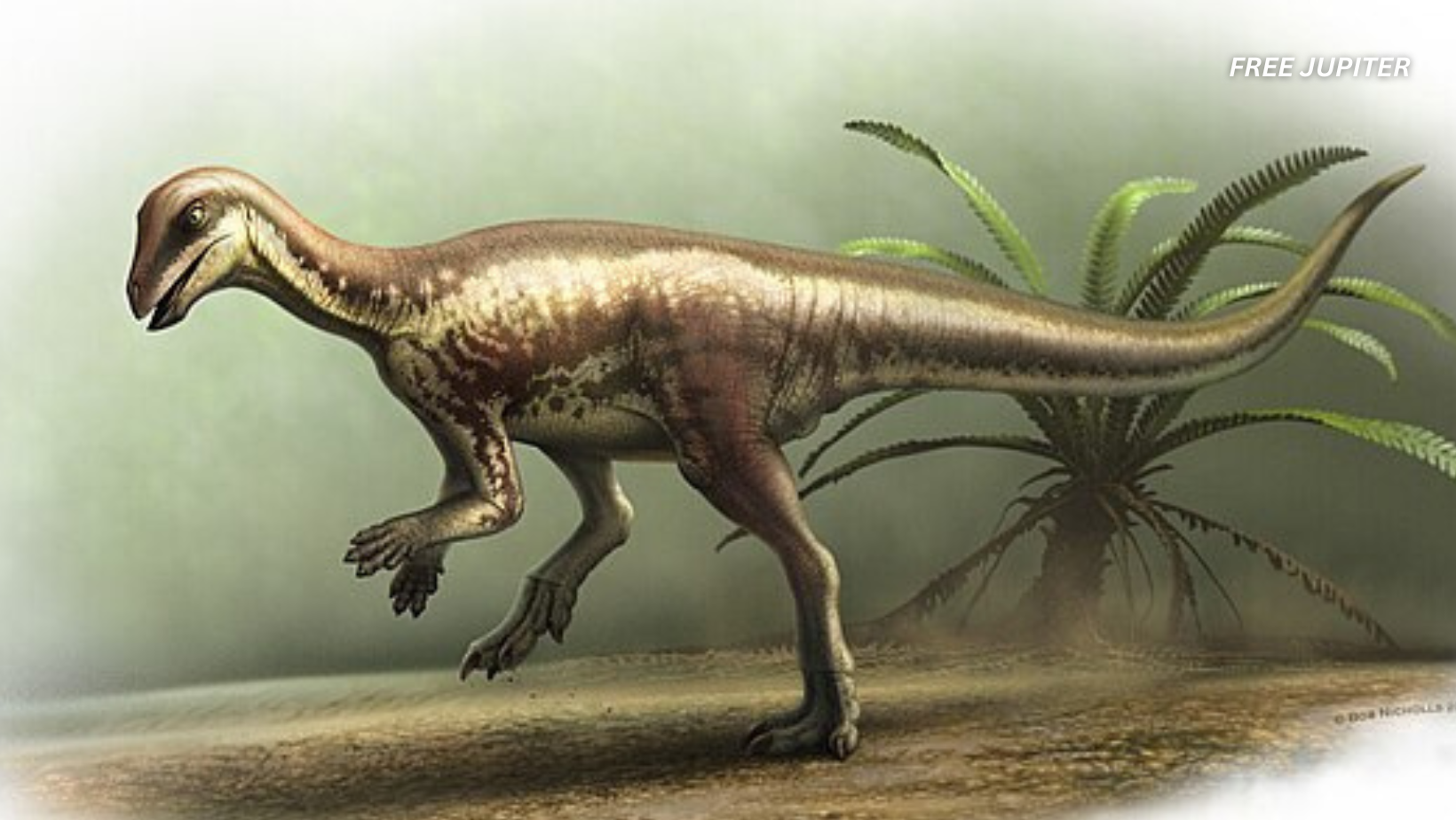Friendly Note: FreeJupiter.com shares general info for curious minds 🌟 Please fact-check all claims—and always check health matters with a professional 💙
When we think of dinosaurs, we usually picture towering T. rexes or long-necked Brachiosaurus slowly lumbering across prehistoric landscapes. But not all dinos were giants. Some were surprisingly small, lightning-fast, and—believe it or not—about the size of your dog. Enter Enigmacursor mollyborthwickae, a newly named Jurassic-era dinosaur that’s rewriting what we thought we knew about life in the time of dinosaurs.
Discovered between 2021 and 2022 in a UK quarry, this nearly complete skeleton has found a permanent home at the Natural History Museum in London. But more than just another addition to the fossil hall, this find is turning heads because it offers something paleontologists rarely get: a fresh glimpse into how small dinosaurs shaped their world.
🧩 Why Enigmacursor Is So Puzzling (and Cool)
Let’s start with the name: Enigmacursor mollyborthwickae.
The first part, Enigmacursor, means “puzzling runner.” It’s a nod to how confusing this little guy was to classify at first—and to its likely ability to move fast on its feet. For a while, experts thought it belonged to the Nanosaurus group, a genus now considered outdated and essentially erased from the official dinosaur registry.
But thanks to some serious detective work by scientists, especially NHM paleontologist Dr. Susannah Maidment, the fossil was identified as a completely new species. It wasn’t just a misfit—it was a missing puzzle piece. According to Maidment, this discovery “rewrites what scientists thought they knew about these ancient ecosystems.” And that’s not an exaggeration.
🌍 What the Jurassic Was Really Like
Enigmacursor lived roughly 150 million years ago—right in the thick of the Late Jurassic period. Back then, Earth looked very different. Europe was a series of islands, temperatures were warmer, and vegetation was lush and varied. The land was dominated by giants like Stegosaurus, but in between the thundering footsteps of the herbivore titans were smaller, nimbler dinosaurs that lived very different lives.
While Stegosaurus chomped on ferns and traveled in herds, Enigmacursor likely thrived in the quieter corners of the forest—dashing through thick underbrush, munching on low-lying plants, and dodging predators with quick reflexes. Think of it as the Jurassic version of a squirrel or a gazelle: small, alert, and built for speed.
Read more: Scientists Reveal The Oldest Rocks Ever Found on Planet Earth
🦴 Built Like a Runner, Not a Fighter
If you were to design a dinosaur with survival in mind—one that didn’t rely on claws, fangs, or brute strength—you’d likely end up with something a lot like Enigmacursor mollyborthwickae. Everything about this dog-sized dinosaur seems optimized not for confrontation, but for agility, balance, and speed. It was nature’s version of a sprinter, not a gladiator.
⚖️ A Tail That Did More Than Wag
One of the most striking features of Enigmacursor is its long, whip-like tail. Unlike bulky tails used by some dinosaurs for brute force, Enigmacursor’s tail was slim, lightweight, and longer than the rest of its body. Scientists believe it played a critical role in helping the dinosaur stay balanced while it darted through forest floors, leaping over rocks or making sharp turns to escape predators.
In animals today—like kangaroos or cheetahs—tails serve a similar purpose, helping with stabilization and control during rapid movement. In Enigmacursor’s case, it was likely essential for keeping it upright while running at high speeds. The tail may have also been used for social signaling, perhaps to communicate with others in its group, or even to distract predators with sudden flicks.
👣 Feet Made for Flight, Not Fight
Now let’s talk feet. While its body was compact, its feet were disproportionately large—especially when compared to other small herbivorous dinosaurs. That’s not a fluke. Bigger feet mean more surface area for pushing off the ground, which translates to better traction and faster movement. Think of it like a sprinter wearing track shoes with spikes—Enigmacursor was built to grip the earth and take off in an instant.
These sturdy feet, paired with long, powerful hind legs, point to an animal that could run—and run well. It may not have been the fastest dinosaur to ever live, but in its ecosystem, it was likely near the top of the agility charts.
Interestingly, some researchers believe its claws may have also served a multipurpose function. While not weapons in the traditional sense, they could have helped the dinosaur scratch through underbrush, dig up roots, or gain traction on slippery terrain.
🧠 When Brains Take a Backseat
Now, don’t expect Enigmacursor to have passed any dinosaur IQ tests. With a relatively small head and likely a modest brain tucked inside, this wasn’t a creature known for clever tactics or complex social behavior. But in nature, intelligence comes in many forms—and sometimes, instinct and physical design are more than enough to keep a species alive.
Enigmacursor’s smarts may have been basic, but they were effective: sense danger, bolt quickly, stay hidden, and come out only when it’s safe to graze. In many ways, this made it the Jurassic equivalent of a deer or antelope—alert, reactive, and nimble.
Read more: Humans Are Still Evolving—And Our Teeth Might Be Disappearing: New Study
🏃♂️ Survival Through Speed
In a world full of sharp-toothed predators like Allosaurus or the powerful jaws of smaller theropods, defense through armor or aggression wasn’t always the best option. For Enigmacursor, speed was its defense. If danger approached, its best bet wasn’t to fight—it was to vanish into the underbrush before it ever got too close.
This strategy is still common in the animal kingdom today. Think of rabbits, gazelles, and even chickens. They don’t need sharp teeth to survive—just fast legs, strong reflexes, and a good sense of when to run.
🔍 Related Discoveries That Back It Up
Enigmacursor isn’t the only small, fast dinosaur shaking things up. Here are a few other discoveries that show why the little guys deserve more attention:
🦖 Fruitadens haagarorum – The Jurassic Mini-Dino
This tiny dinosaur from North America was smaller than a housecat and lived around the same time as Enigmacursor. It too had strong legs, suggesting it could zip through the forests and survive on speed.
🦕 Heterodontosaurus – The “Odd-Toothed” Runner
With a mix of teeth suited for both plants and possibly small insects, Heterodontosaurus gives scientists a look at how diverse small herbivores could be. It also had strong hind legs for running.
🧠 What We Still Don’t Know (Yet)
While the fossil of Enigmacursor is unusually complete, there’s still a lot to learn. Scientists are currently analyzing microscopic details in its bones to determine its exact age, growth rate, and even potential behaviors.
Could it have lived in groups? Was it territorial? Did it raise its young? These questions are still up in the air—but the discovery opens the door for new research into how small, fast dinosaurs survived and thrived among Jurassic giants.
Read more: Newly Discovered Dinosaur Species Rewrites The T. Rex Family Tree
📚 Why This Matters
Each new fossil like Enigmacursor mollyborthwickae isn’t just another name to memorize—it’s a clue to how ancient life evolved and functioned. It helps scientists understand not just what the Jurassic looked like, but how it worked. And the more we know about prehistoric ecosystems, the more we can learn about biodiversity, climate change, and survival on a constantly shifting planet.
So next time someone says dinosaurs were all just oversized reptiles, tell them about the little runner that lived fast and left a fossil. Enigmacursor may have been small, but its story is a big deal.










